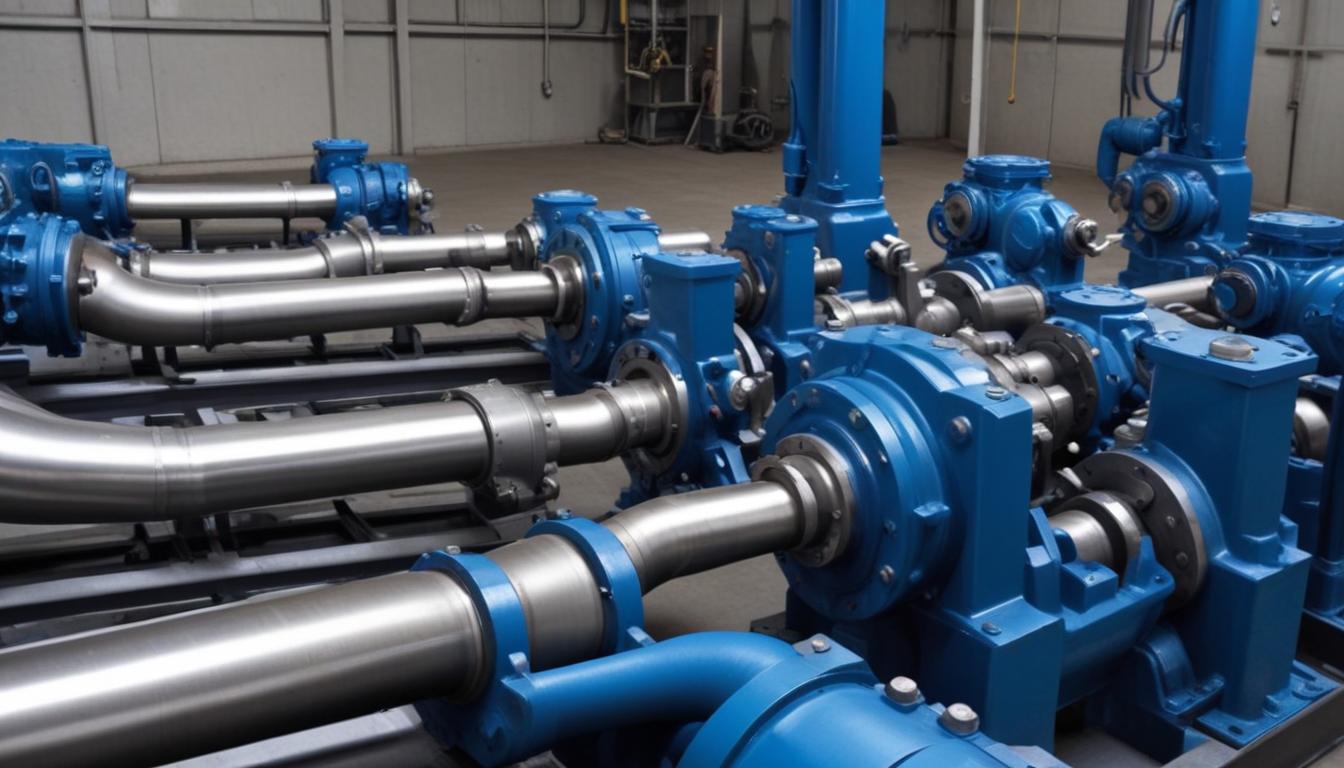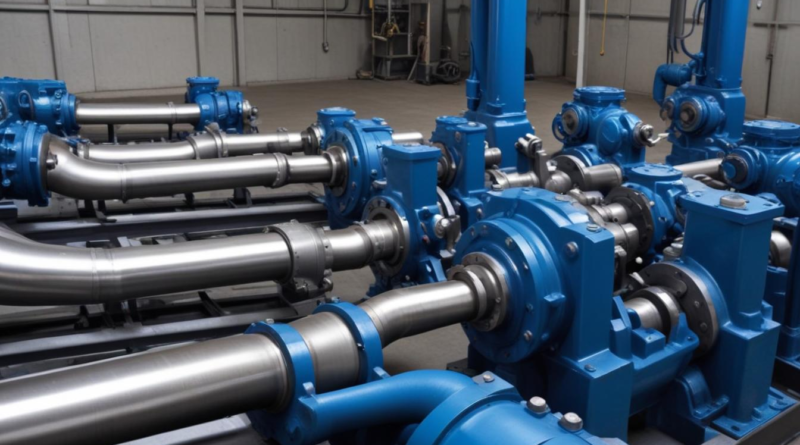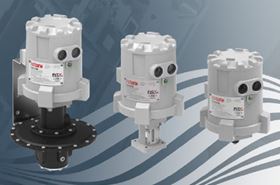the role of pumps in hydraulic systems
Hydraulic systems utilize a variety of pump types, each with unique characteristics that fulfill specific roles and enhance system functionality. Understanding these differences is essential for selecting the appropriate pump for any application.
- Gear Pumps: These are among the simplest and most widely used hydraulic pumps. They operate by the meshing of gears to transfer fluid, making them highly reliable and cost-effective. Gear pumps are ideal for low to medium-pressure applications and are commonly found in mobile machinery and basic industrial systems.
- Vane Pumps: Vane pumps feature a series of vanes mounted on a rotor that slides within the pump housing. This design allows for variable displacement, providing greater efficiency and adaptability compared to gear pumps. Vane pumps are suitable for applications requiring adjustable flow rates, such as automotive systems and versatile industrial machinery.
- Piston Pumps: Utilizing reciprocating pistons, these pumps can handle high pressures and offer precise flow control. Piston pumps are essential in heavy-duty applications, including aerospace, construction equipment, and high-performance industrial machinery, where both durability and accuracy are paramount.
- Screw Pumps: Screw pumps employ one or more screws to move fluid along the pump axis. They are known for their ability to deliver high flow rates with minimal pulsation, making them ideal for continuous flow applications. Screw pumps are often used in large-scale industrial systems and processes that demand smooth and consistent fluid movement.
| Type | Advantages | Typical Applications |
|---|---|---|
| Gear Pumps | Simple design, reliable operation, cost-effective | Mobile machinery, basic hydraulic systems |
| Vane Pumps | Adjustable displacement, higher efficiency | Adjustable flow systems, automotive applications |
| Piston Pumps | High pressure capability, precise control | Heavy-duty equipment, aerospace, precision machinery |
| Screw Pumps | High flow rate, low pulsation | Continuous flow applications, large industrial processes |
Each type of hydraulic pump plays a pivotal role in optimizing the performance and efficiency of hydraulic systems, providing the necessary functionality to meet the diverse demands of various industries.
pump selection criteria
Selecting the appropriate hydraulic pump is crucial to ensure the optimal performance and reliability of hydraulic systems. Several factors must be carefully evaluated to match the pump’s capabilities with the system’s requirements.
Flow Rate and Pressure Requirements
The primary considerations in pump selection are the flow rate and pressure needed for the application. The flow rate, typically measured in gallons per minute (GPM) or liters per minute (LPM), determines how much fluid the pump can deliver. Pressure, measured in pounds per square inch (PSI) or bar, indicates the force the pump can exert. It is essential to choose a pump that can consistently meet or exceed the system’s maximum pressure and provide adequate flow to maintain functionality under all operating conditions.
Efficiency and Performance
Efficiency affects both the operational cost and the thermal management of the hydraulic system. High-efficiency pumps reduce energy consumption and minimize heat generation, contributing to longer system life and lower operating expenses. When evaluating efficiency, consider factors such as volumetric and mechanical efficiency, which influence the overall performance and responsiveness of the system.
Fluid Compatibility
Hydraulic pumps must be compatible with the type of fluid used in the system. Factors such as viscosity, temperature, and the presence of contaminants can affect pump performance and longevity. Selecting a pump with materials and seals that are resistant to the specific hydraulic fluid ensures reliability and reduces the risk of leaks or failures.
System Design and Configuration
The design and configuration of the hydraulic system play a significant role in pump selection. Considerations include whether the system is open or closed, the required direction of fluid flow, and the integration with other components such as valves, actuators, and reservoirs. Additionally, the pump’s displacement type (fixed or variable) should align with the system’s operational requirements.
Maintenance and Reliability
Reliability and ease of maintenance are vital for minimizing downtime and ensuring continuous operation. Pumps with fewer moving parts, such as gear pumps, generally require less maintenance compared to more complex designs like piston pumps. Evaluating the availability of replacement parts and the ease of performing routine maintenance tasks can influence the long-term sustainability of the hydraulic system.
Cost Considerations
Initial purchase cost, installation expenses, and long-term operational costs must all be considered. While higher-quality pumps may have a higher upfront cost, their efficiency and durability can lead to cost savings over time. A comprehensive cost analysis helps in selecting a pump that offers the best balance between performance and budget constraints.
Environmental Factors
The operating environment, including temperature extremes, exposure to dust or water, and space limitations, can impact pump performance. Selecting a pump designed to withstand specific environmental conditions ensures reliable operation and extends the lifespan of the hydraulic system.
Technical Support and Manufacturer Reputation
Choosing a pump from a reputable manufacturer that offers robust technical support and warranty services can provide added assurance. Reliable technical support can assist with troubleshooting, maintenance guidance, and ensuring the pump operates effectively within the system.
Summary of Selection Criteria
The following table summarizes key criteria to consider when selecting hydraulic pumps:
| Selection Criteria | Description |
|---|---|
| Flow Rate | Determine the required fluid delivery rate to meet system demands. |
| Pressure | Ensure the pump can achieve and sustain the necessary operating pressure. |
| Efficiency | Choose pumps with high efficiency to reduce energy consumption and heat. |
| Fluid Compatibility | Select materials and seals compatible with the hydraulic fluid used. |
| System Design | Match the pump type and displacement with the system’s configuration. |
| Maintenance | Consider ease of maintenance and availability of spare parts. |
| Cost | Balance initial and long-term costs against performance and reliability. |
| Environmental Factors | Ensure the pump is suitable for the operating environment. |
| Technical Support | Prefer manufacturers with strong support and warranty options. |
By meticulously evaluating these criteria, engineers and decision-makers can select hydraulic pumps that not only meet the immediate requirements but also provide sustainable performance and reliability for the hydraulic system’s role in various applications.
operational principles
Hydraulic pumps function by converting mechanical energy into hydraulic energy, enabling the smooth and efficient transfer of fluid within a hydraulic system. At the core of this conversion process lies the principle of positive displacement, where a specific volume of fluid is moved with each cycle of the pump. This ensures a consistent and controllable flow rate, which is critical for the reliable operation of hydraulic machinery.
Energy Conversion Process
The primary operation of hydraulic pumps involves the intake of hydraulic fluid from the reservoir and its subsequent pressurization. This is achieved through the movement of internal components such as gears, vanes, pistons, or screws, depending on the pump type. As these components move, they create cavities that draw fluid into the pump and then force it out under pressure towards the hydraulic actuators or motors.
Flow Control Mechanisms
Effective flow control is essential for the precise operation of hydraulic systems. Pumps achieve this through various mechanisms:
- Displacement Control: Adjusting the displacement per cycle allows for variable flow rates. Variable displacement pumps can modify the volume of fluid displaced without altering the pump speed, providing greater flexibility and efficiency.
- Flow Regulation: Valves and electronic controls regulate the flow rate and direction of the hydraulic fluid, ensuring that actuators receive the appropriate amount of energy for their specific tasks.
Pressure Regulation
Maintaining optimal pressure levels is crucial to prevent system overloads and ensure smooth operation. Hydraulic pumps incorporate pressure relief valves and accumulators to manage and stabilize pressure within the system. These components help absorb pressure spikes and maintain a steady flow, enhancing the overall reliability and safety of the hydraulic system.
Efficiency Factors
The efficiency of hydraulic pumps is influenced by several factors, including mechanical design, lubrication, and thermal management. High-efficiency pumps minimize energy losses due to friction and heat generation, which not only reduces operational costs but also extends the lifespan of both the pump and the overall hydraulic system.
Types of Positive Displacement Pumps
Different types of positive displacement pumps operate on unique mechanisms to achieve fluid displacement:
- Gear Pumps: Utilize meshing gears to create pressure and move fluid.
- Vane Pumps: Employ sliding vanes within a rotor to regulate fluid flow.
- Piston Pumps: Use reciprocating pistons to generate high-pressure fluid flow.
- Screw Pumps: Move fluid along threaded screws, providing smooth and continuous flow.
Integration with Hydraulic Systems
Hydraulic pumps are integral to the functionality of various hydraulic systems, seamlessly working with other components such as reservoirs, filters, actuators, and control valves. The precise coordination between the pump and these components ensures that the system operates efficiently and responds accurately to control inputs.
| Operational Aspect | Description |
|---|---|
| Energy Conversion | Converts mechanical energy into hydraulic energy through positive displacement. |
| Flow Control | Regulates the rate and direction of fluid flow using displacement control and valves. |
| Pressure Regulation | Maintains optimal pressure levels with relief valves and accumulators. |
| Efficiency Management | Minimizes energy losses through design optimization and thermal management. |
| System Integration | Works in harmony with other hydraulic components to ensure seamless operation. |
The operational principles of hydraulic pumps are fundamental to their role in hydraulic systems, ensuring that mechanical tasks are performed with precision and reliability across various industrial applications.
maintenance and troubleshooting
 Regular Maintenance Practices
Regular Maintenance Practices
Maintaining the optimal performance of hydraulic pumps is essential to ensure the longevity and reliability of the entire hydraulic system. Regular maintenance involves a series of routine checks and procedures designed to identify and address potential issues before they escalate into significant problems.
- Inspection for Leaks: Daily inspections should be conducted to identify any signs of fluid leaks around the pump and associated hoses. Early detection of leaks can prevent fluid loss and avoid potential damage to other system components.
- Fluid Level and Quality Checks: Regularly monitor the hydraulic fluid levels to ensure they remain within the recommended range. Additionally, assess the fluid quality for signs of contamination, such as discoloration or the presence of particulates, which can impair pump functionality.
- Filter Maintenance: Clean and replace hydraulic filters as per the manufacturer’s guidelines. Clogged or dirty filters can restrict fluid flow, reduce efficiency, and increase wear on pump components.
- Lubrication of Moving Parts: Ensure that all moving parts, including bearings and seals, are adequately lubricated. Proper lubrication minimizes friction, reduces wear, and enhances the overall efficiency of the pump.
- Monitoring for Unusual Noises or Vibrations: Pay attention to any abnormal sounds or vibrations emanating from the pump, as these can be indicators of underlying issues such as misalignment, worn components, or inadequate lubrication.
Preventive Maintenance Strategies
Implementing a preventive maintenance schedule is crucial for anticipating and mitigating potential failures. This proactive approach helps in maintaining consistent pump performance and reduces unexpected downtime.
- Scheduled Maintenance Plans: Develop and adhere to a maintenance schedule based on the manufacturer’s recommendations and the operational demands of the hydraulic system. Regularly scheduled maintenance tasks help in early detection of wear and tear.
- Tracking Operating Hours: Keep accurate records of the pump’s operating hours to determine optimal times for performing maintenance tasks. This data-driven approach ensures that maintenance activities are performed at appropriate intervals.
Common Troubleshooting Issues
Despite regular maintenance, hydraulic pumps may encounter issues that require troubleshooting to restore proper functionality. Understanding common problems and their solutions is essential for maintaining system efficiency.
| Issue | Possible Causes | Solutions |
|---|---|---|
| Fluid Leaks | Worn seals, loose fittings, damaged hoses | Replace faulty seals, tighten fittings, or replace damaged hoses. |
| Low Pressure | Insufficient fluid level, blocked filters, pump wear | Check and replenish fluid levels, clean or replace filters, inspect and repair pump components. |
| Overheating | Inadequate cooling, excessive load, contamination | Ensure proper cooling, reduce system load, and maintain fluid cleanliness. |
| Unusual Noises | Internal component wear, air in the system, misalignment | Inspect and replace worn parts, bleed the system to remove air, and realign pump components. |
| Vibrations | Pump imbalance, loose mounts, bearing failure | Balance the pump, secure mounting points, and replace damaged bearings. |
Diagnostic Tools and Techniques
Accurate diagnosis of hydraulic pump issues is facilitated by a variety of specialized tools and techniques. Employing these tools ensures effective troubleshooting and minimizes downtime.
- Visual Inspections: Conduct regular visual checks to identify obvious signs of wear, leaks, or component damage.
- Pressure Gauges: Utilize pressure gauges to monitor system pressure and identify deviations from normal operating ranges.
- Thermal Imaging: Employ thermal cameras to detect overheating components, which can indicate excessive friction or inadequate lubrication.
- Vibration Analysis: Use vibration meters to assess the condition of bearings and rotating parts, identifying imbalances or misalignments.
Best Practices for Maintenance and Troubleshooting
Adhering to best practices can significantly enhance the efficiency and reliability of hydraulic pumps. Implementing these strategies fosters a proactive maintenance culture and ensures the sustained performance of hydraulic systems.
- Adherence to Manufacturer Guidelines: Follow the maintenance and troubleshooting procedures outlined by the pump manufacturer to ensure compatibility and effectiveness.
- Training Personnel: Ensure that maintenance staff are adequately trained and knowledgeable about the specific types of hydraulic pumps and their operational requirements.
- Documentation and Record-Keeping: Maintain detailed records of all maintenance activities, repairs, and inspections. This documentation aids in tracking the pump’s performance history and identifying recurring issues.
- Use of Genuine Parts: Utilize original manufacturer parts for replacements to maintain pump integrity and performance standards.
Replacement of Wear Parts
Over time, components within hydraulic pumps experience wear and tear, necessitating timely replacement to prevent system failures. Key wear parts include seals, bearings, gears, and pistons, depending on the pump type.
- Seals: Regularly inspect seals for signs of deterioration or leakage and replace them as needed to maintain system integrity.
- Bearings: Monitor bearing conditions and replace them if excessive play, noise, or overheating is detected.
- Gears and Pistons: For gear and piston pumps, inspect internal components for wear and replace any damaged parts to ensure efficient fluid movement.
By implementing comprehensive maintenance and effective troubleshooting practices, the functionality and reliability of hydraulic pumps are significantly enhanced, ensuring their pivotal role in various industrial applications remains uncompromised.
applications in various industries
Hydraulic pumps are integral to a wide array of industries, each leveraging their unique capabilities to enhance operational efficiency and performance. Their versatility and reliability make them indispensable in applications ranging from heavy machinery to precision equipment.
- Construction Industry: Hydraulic pumps power essential equipment such as excavators, bulldozers, and cranes. They enable precise control and movement, allowing for tasks like digging, lifting, and material transport with high efficiency and safety.
- Agriculture: Farm machinery, including tractors, harvesters, and sprayers, rely on hydraulic pumps for tasks such as lifting implements, adjusting machinery settings, and managing fluid flow for irrigation systems.
- Aerospace: In aerospace applications, hydraulic pumps are critical for controlling flight surfaces, landing gear, and other vital systems. Their ability to deliver high pressure and precise control ensures the safety and reliability of aircraft operations.
- Automotive: Hydraulic systems in vehicles are powered by pumps to operate brake systems, power steering, and automatic transmissions. These pumps ensure smooth and responsive control, enhancing vehicle performance and safety.
- Manufacturing and Industrial Machinery: Hydraulic pumps drive a variety of industrial equipment, including presses, injection molding machines, and assembly line components. They provide the necessary force and control for high-precision manufacturing processes.
- Mining: Heavy-duty hydraulic pumps are essential in mining operations for powering drills, loaders, and conveyor systems. Their robustness and ability to operate in harsh environments make them suitable for extracting and transporting minerals efficiently.
- Marine: Ships and offshore platforms use hydraulic pumps for steering, anchoring, and operating deck machinery. Their reliability under demanding marine conditions is crucial for maintaining vessel control and operational integrity.
- Energy Sector: In renewable energy applications, such as hydroelectric power plants, hydraulic pumps manage fluid flow and control turbine operations. They also play a role in oil and gas industries for hydraulic fracturing and pipeline maintenance.
Key Applications Across Industries
| Industry | Applications | Benefits |
|---|---|---|
| Construction | Excavators, cranes, bulldozers | Enhanced control, increased lifting capacity, improved safety |
| Agriculture | Tractors, harvesters, irrigation systems | Optimized performance, versatile functionality, efficient operation |
| Aerospace | Flight control systems, landing gear, actuators | High precision, reliability, safety |
| Automotive | Brake systems, power steering, transmissions | Responsive control, improved safety, enhanced vehicle performance |
| Manufacturing | Presses, injection molding, assembly lines | High precision, consistent performance, efficiency |
| Mining | Drills, loaders, conveyors | Durability, operational efficiency, ability to handle heavy loads |
| Marine | Steering systems, deck machinery, anchoring | Reliability in harsh conditions, precise control, operational integrity |
| Energy | Hydroelectric turbines, hydraulic fracturing, pipeline maintenance | Efficient fluid management, reliable operation, enhanced energy production |
The role of hydraulic pumps in these industries cannot be overstated. They provide the necessary functionality to perform complex and demanding tasks with precision and reliability. As technology advances, the integration of intelligent hydraulic systems continues to expand, further enhancing the capabilities and applications of hydraulic pumps across diverse sectors.




